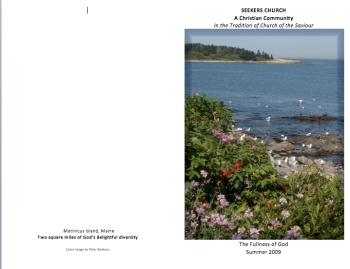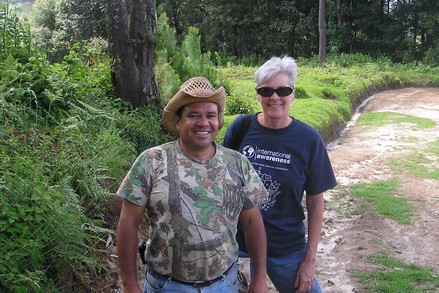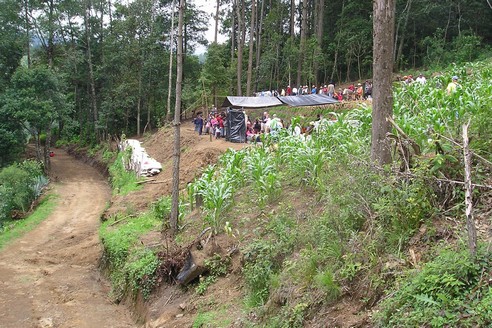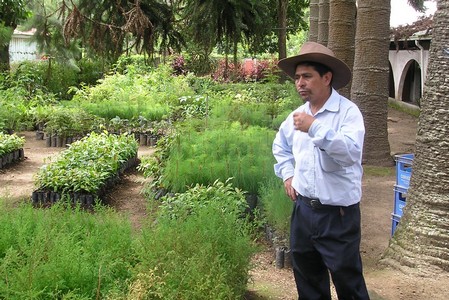 "A Church of the Real Way" by Peter Bankson
"A Church of the Real Way" by Peter Bankson
August 2, 2009
INTRODUCTION
Last Tuesday evening our pilgrims returned from 10 days in Guatemala that included a week of work with the people of las Lomas, Tecpan, in Chimaltenango. We were working together on the foundation of their new school. It was work that’s familiar to many of you who have been on earlier pilgrimages. This year’s pilgrimage was a time for me to think about who God seems to be calling us to be.
THE CHURCH OF THE WAY
As I was getting ready for the pilgrimage I was reading "Saving Jesus from the Church" by Robin Meyers. He makes a strong case for looking at Jesus as a sage and teacher rather than a magician. That fit the image I’ve carried for a long time – that Jesus was a guy who "got" what it means to be a child of God, a steward of the Earth and the creatures who live on it. Meyers talks a lot about what it means to follow Jesus rather than only worship "the Christ." In his chapter on "Discipleship as Obedience, Not Observance" he says, "One of the first questions any churchgoer should be asking and expected to answer is: What are you willing to give up to follow Jesus?" That pointed me back toward who I am, who we were as a group of pilgrims in Guatemala and who we are here at Seekers Church.
The first night in Antigua, Guatemala was clear and cool with a lovely sunset. Heading back to our quarters at the Lutheran Center, I turned a familiar corner onto Avienda Uno Norte and noticed a sign that said "la Iglesia del Camino." At first I thought that meant "street church," but soon enough it connected with what I’d been reading and I saw it as the Church of the Way. (My Spanish is still muy pocito!) So here was a church that sees itself as a church of the Way. I wondered what being with them in worship would feel like to me? I often think about us here as a Church of the Way. Would Iglesia del Camino in Antigua be just like Seekers Church? Probably not. Would that be a problem? Not as far as I could tell. I never did go by la Iglesia del Camino when it was open, but the name stuck with me for rest of our pilgrimage. I want to know that I’m part of la Iglesia del Camino Real, the real church of the Way of Jesus.
Our call to be church holds up for me a strong invitation to be on the Way with Jesus. The call is printed on the back of the liturgy for this season if you want to take a look.
Our call is to be a "Seekers community" which comes together in weekly worship rooted in the Biblical faith, with shared leadership; and disperses with a common commitment to understand and implement Christian servanthood in the structures in which we live our lives.
…
For us, Christian servanthood is based on empowering others within the normal structures of our daily lives (work; family and primary relationships; and citizenship) as well as through special structures for service and witness. We desire and welcome participation in Seekers of women and men of every race and sexual orientation. In Seekers Church we will equip and support each other in all of these areas and seek a balance among them.
(From the Call of Seekers Church)
We say that, for us, being on the Way means welcoming everyone who comes, and helping each other empower those we meet wherever we are out there in the wider world. It’s a form of ministry in daily life that cries out for a companion to share the journey, and we try to be companions to each other while we’re on the Way.
Since I started working with Roboin Meyers’ book and saw that sign in Antigua for la Iglesia del Camino I’ve been thinking about what different ways we can respond as a faith community to help one another live out God’s call. In my experience, living out this commitment can take lots of different shapes. We want to be a place where that kind of spiritual companionship is available to each of us. If you’d like to know more, let me know.
 TWO EXAMPLES OF MINISTRY IN DAILY LIFE: JUAN AND TORRIBIO
TWO EXAMPLES OF MINISTRY IN DAILY LIFE: JUAN AND TORRIBIO
While we were in Guatemala I met two people who seemed to model two different versions of this ministry in daily life, Torribio Chajil, the church arborist in San Lucas Toliman and Juan Porras, who drove our bus for most of the time we were in Guatemala. I’ll start with Juan.
I had a troubled initial impression of Juan. He arrived 30 minutes late to pick us up for breakfast on the first day. He explained that he’d had to get permission from his boss to change the oil in the bus and the boss hadn’t been at work until 7:00 am, so 7:20 was as early as he could get there. His fluent but "touristy" English raised my suspicions.
But when we got to las Lomas he joined us as we hiked over the hill, and started working as part of our team. By the end of the day I was able to confess my earlier judgment and begin to get to know him. His story might sound familiar – father died when he was young and mother sold the farm … caught by the military and drafted at 16 … shot in the back in combat and spent a year learning to walk again … working now to help support his 25 year old son who is studying agronomy and holding a dream of joining that son to buy and operate a coffee farm. His job driving a touristico bus is an investment in his family’s future, but didn’t look much like ministry by most standards … yet.

Las Lomas sits at the end of a VERY narrow, four-mile dirt road off the Pan American highway. Its as far north as you can go in Chimaltenango, a small aldea of farmers whose corn and pea fields carpet the steep hillsides in living testimony to the regular rainfall that keeps the village alive and the roads precarious.
When we arrived, the men of las Lomas had already finished digging the foundation trenches. We learned that this village had just become independent from the larger village up the road so that they could have a school of their own, rather than have to have their children walk 2 ½ miles each way to school every day. They were eager to have their own school – and a new building they could use as a community center as well.
We were spared a week of hauling mud in wheelbarrows but there was a lot of rebar to bend, reinforcing columns to tie and concrete block to move up ten feet from the staging level to where the school would sit, nestled into the side of the steep hill.
The second day we were ready to pour the footing for the foundation. PAVA, the Mayan organization that supports this school construction by the village and coordinated our work there, has a new cement mixer, and we got right to work, carrying bags of sand and gravel up to the school site, and hauling buckets of concrete to the trenches. Ask Steve Estrada what it was like to spend the day filling bucket after bucket with concrete! By the end of the day we’d dubbed him "Senor Cemento!"
After an exciting hour the "pour" suddenly ground to a halt as the mixer stopped and couldn’t be started again. Ray Millard, one of the veteran pilgrims who has a lot of small engine experience as a sailor and Coast Guard Captain, was trying to figure out what was wrong. It didn’t help that the cover on the engine was on so tight that Ray bent a screwdriver getting it loose. When they determined that the fuel filter was damaged beyond repair, Mardequeo, the PAVA project coordinator took off to buy a new one in Tecpan, about an hour away. In the meantime the cement mixer sat silent. Ray and the masons and Juan kept trying to find a solution while the rest of us went back to work. There was still a lot of rebar to bend and it kept our minds off the broken cement mixer we couldn’t do anything about.
After a long silence, with occasional requests for small tools, I heard the starter crank, and the cement mixer was running again!
At first I thought that Mardequeo had returned with the new part, but no, it was Juan who had empowered us to continue the pour.
It turns out that after his year in the hospital, Juan’s injured back wouldn’t support heavy labor any more, so he learned to be a mechanic specializing in the small motors that power boats … and cement mixers. When he saw that the fuel filter was broken he figured out that the tube connecting the gas tank and the carburetor might be the same size as the tubing the farmers were using on their fertilizer sprayers. So he got enough from one of the guys, cleaned it out carefully, and connected the parts. Since the fuel filter was missing now he just used his handkerchief to strain enough fuel for the rest of the day. We were back in business and the foundation footings were poured in one piece, like they should be.
On the ride home I thought about that part of paragraph 4 of our call that says, "For us, Christian servanthood is based on empowering others within the normal structures of our daily lives …"
That day Juan was walking our talk. And he kept it up for the rest of the week, tying rebar, hauling bags of rock and sand up the hill, finding a place in line the day we formed a human chain to move about 100 concrete blocks up the hill. At the end of the week in las Lomas I told Juan that I thought of him as uno ministerio de la iglesia del camio real. As a mark of his ministry I gave him a set of multi tools in a belt pouch so he’d always have them handy. When we parted at the airport at the end of the pilgrimage we said "Gracias a Dios," thanks be to God, and he patted the multitools on his belt.
Juan was certainly living out "Paragraph 4" of our call all week. And I think, in some small way we were doing the same for him as we welcomed him onto our team, empowering him to see his life an a larger context. At least that’s part of my prayer.
==
 The other example of Christian servanthood that I mentioned earlier is Torribio Chajil, the church arborist on the staff of Father Greg Shaeffer’s church. For the past 30 years he’s been running the church’s reforestation project in San Lucas Toliman. This visit Toribio wasn’t as busy as he’s been in the past and we had an amazing time together.
The other example of Christian servanthood that I mentioned earlier is Torribio Chajil, the church arborist on the staff of Father Greg Shaeffer’s church. For the past 30 years he’s been running the church’s reforestation project in San Lucas Toliman. This visit Toribio wasn’t as busy as he’s been in the past and we had an amazing time together.
His nursery provides trees for many reforestation projects as well as seedling coffee bushes to support the church’s coffee cooperative. When we visited the coffee cooperative we learned that since that microenterprise ministry of the church began in 1990 with 6 families, it has grown to 650 families who benefit from being part of a working faith community.
Since we’d already heard about the coffee, Toribio focused on the trees. First, he told us that in Kaqchikel, his native language, the name of his land is "Home of Trees."
Trees connect earth and heaven;
Trees provide food and shelter;
Trees give wood; and
Trees hold back landslides.
He said the while God had made Guatemala very steep and subject to landslides, God gave the people special trees to help keep the land in place.
His calling as church arborist and leader of the reforestation project is to:
Find good mother trees and collect their seeds;
Nurture the seedlings so they are strong and ready for planting; and
Plant each tree in a good place.
As he finished a moving talk with us, his conclusion sounded familiar: "We are all children of our mothers; we are all children of the trees; we are all children of the earth. God cares for the earth and will guide us into the future. We are called to hope, and to help.
He’s been there for 30 years, finding good mother trees and helping their seeds find good places to grow. This was the 9th time I’ve visited with him and from what I heard this time he’s clearly working in the ordinary structures of San Lucas Toliman to empower others.
WHAT ABOUT US?
The conversation about who God is calling us to be seems to be gaining momentum here at Seekers. The Stewards have been talking about it now for several months. Mission groups have been invited to join in. We’re planning for a "Third Sunday" conversation once folks get back from summer outings, and there are other opportunities.
I’ve been giving this question of how God is calling us some continuing thought and prayer, adding stories and images from Guatemala to what I see around here. Sitting on the bus last week as Juan drove us to the school site I was aware that the busload was about half the size of this congregation. While we were on the road, Juan was in charge. Given his experience and the traffic in Guatemala the rest of us were glad to affirm his gifts! When we got to the job site, the mason was the "hefe" who called the shots: distributed leadership in action.
Some of the pilgrims had been on more than half a dozen trips, but 2/3 of us were new to the experience. When we climbed off the bus and headed over the hill to the school site we had an opportunity to be on mission together, to be on the way with Jesus. Oh, it wasn’t perfect: there were frustrations and unmet expectations, but by the end of our week of work, when the lead teacher of the school lifted up a special piñata for the gringos to break and Annie took the first swings, I could feel that we’d come a long way.
We’d been present to each other, even when it wasn’t convenient;
We were learning to trust each other;
Our shared vision of the new school in las Lomas had helped us focus on what was important and where to invest our limited time and energy; and
When there were tasks that nobody wanted to do – things like carrying the almost full five-gallon water garaphon back over the hill at the end of the day – one of us would recognize the need and do their duty without much hesitation.
That busload of pilgrims had become a community – maybe even a little congregation of la iglesia del camino real.
Around here we’re on the same journey. Some of us have been on the bus for a long time. Others are still looking for a seat, wondering where we’re headed and what to talk about with that new seatmate. Some of us are looking out the windows, checking the weather or following our progress on the map. Others are wondering what it means to give up some old assumption to be on the Way.
And later today after we’ve scattered into those ordinary structures of our lives, each of us will have the opportunity to practice Christian servanthood by empowering others.
CONCLUSION
As far as I can tell, we’re on the road … together. According to the map I have, it’s the road Jesus is on. Some of us are paying more attention to that than others, and that’s OK. It seems to me that we spend more time thinking about what Jesus is inviting us to do than we do arguing over all those swirling winds of doctrine that Paul was writing about in his letter to the Ephesians, and that feels like good news to me. One good way to avoid being swept away in the wind is to focus on that Christian servanthood we talk about in our call, going out from this place "with a common commitment to understand and implement Christian servanthood in the structures in which we live our lives."
As I think about Juan Porras and Torribio Chajil and remember that bus full of pilgrims heading into las Lomas, I think about being more present, learning to trust, sharing our vision of God’s call, and stepping in when duty calls. For me, these are some of the places where I can imaging giving up some old pattern or prejudice so I can be more clearly on the Way.
And, as I look out at us gathering around this table of forgiveness and community I pray that we will trust that the presence of the Holy Spirit in our midst, calling us to clearer understanding of Christian servanthood, of being with Jesus on the Way.
And let’s keep praying.
Amen.